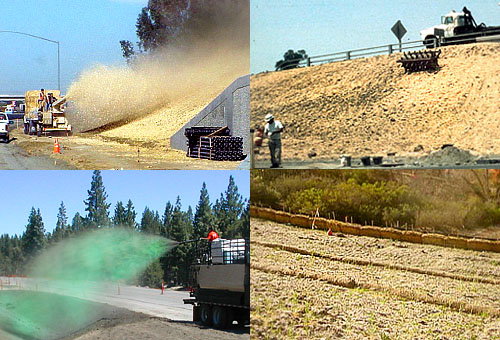Erosion Control Toolbox: Straw
Introduction

Straw is frequently used as a mulch in hydroseeding, often in conjunction with drill seeding. Application rates vary based upon straw material, slope roughness, and slope steepness. Straw may be fastened in place by punching it into the soil with a sheepsfoot roller or by gluing it to the soil surface with hydromulch.
When to Use this Product
- Use for excavation (cut) and embankment (fill) slopes and other disturbed areas
- Typically used to treat disturbed areas greater than 0.5 acre
- Specify a straw type when filling out the Hydroseed and Straw specifications
Benefits
- Immediate protection from surface erosion due to raindrop impact
- Conserves soil moisture
- Conforms closely to the soil surface which may reduce erosion due to surface rilling
- Vegetation provided by seed provides long-term control of erosion
Limitations
- Regional air quality regulations may limit or prohibit blowing of straw. Consider specifying Bonded Fiber Matrix instead
- Applied straw may contain up to 15 pounds of weed seed per ton
Consider Using With
Weed Free Straw
Certified weed-free forage is defined as: hay, feed, straw or straw mulch that has been inspected and certified not to contain propagative plant parts or seeds of noxious weeds. County Agricultural Commissioners, in conjunction with the California Department of Food and Agriculture (CDFA), offer inspection services to certify materials as weed free. A list of producers and suppliers may be found at the following site:
Note:
- If you need a large amount of material for the coming year, contact vendors early in the growing season to ensure certified weed-free forage/straw will be available for your project.
- Proof of certification, in the form of a copy of CDFA Form 66-079 “Certificate of Quarantine Compliance (CQC)” associated with the inspection of the specific forage/straw materials, is the legal documentation verifying that the materials have been inspected.
- Producers seeking certification for weed-free hay and straw may contact County Agricultural Commissioner’s offices for inspection and certification. Contact information is available at: http://www.cdfa.ca.gov/exec/county/countymap/
Straw Types
If you are uncertain which straw product to select, specify wheat straw. Specify rice straw or Certified Weed Free wheat straw where the potential spread of noxious plant species is of concern.
Wheat Straw
Benefits
- Most commonly available straw product
- Commonly available in southern California
Limitations
- Biodegrades more rapidly than rice straw
- Wheat straw may contribute to the spread of invasive weeds. Specifying certified weed free straw would help mitigate this problem
Rice Straw
Benefits
- Use where "weed free" straw is required. Because rice is aquatic, it has minimal weed seed content when used in dry land applications.
- High silicate content causes rice straw to last longer than other straw types
- Using this straw helps satisfy "Rice Straw Burning Reduction Act" of 1991 (AB-1378) requirements
Limitations
- Availability may be limited seasonally. Verify availability at the Rice Straw Market
- As most rice is grown in the Sacramento valley, availability may be limited to northern California
- Rice straw is brittle and does not "punch" well into the soil
Barley Straw
Benefits
- Softer and more absorbent than wheat or rice straw
Limitations
- Availability may be limited compared to wheat straw
Specifications
- Refer to Standard Specifications - Section 21 Erosion Control
Estimate Information
- Use Bid Item Code 210420 Straw
Guidance
- California Department of Transportation, August 2009
- David Steinfield, Scott Riley, Kim Wilkinson, Thomas D. Landis, Lee Riley, et al. 2017. "Roadside Revegetation, An Integrated Approach to Establishing Native Plants and Pollinator Habitat"
Updated: January 8, 2019

